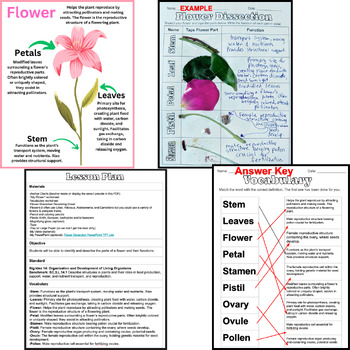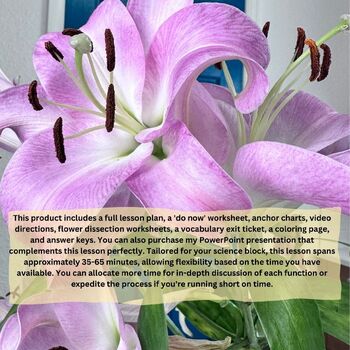Flower Dissection - Parts of a Flower Worksheets, Diagrams, Do Now, Exit Ticket
- PDF
Also included in
- This flower dissection bundle is a great way for students to learn about the parts of a flower. It includes a full lesson plan, a 'do now' worksheet, anchor charts, video directions, flower dissection worksheets, a vocabulary exit ticket, a coloring page, answer keys, and PowerPoint presentation atPrice $3.50Original Price $4.00Save $0.50
- This bundle is ideal for both math and science teachers, providing comprehensive coverage for both subjects. The flower dissection activity is not only enjoyable but also aligns with science standards and vocabulary. The math activities address place value standards, and I've incorporated multiplicaPrice $6.99Original Price $7.99Save $1.00
Description
Help your students learn about the different parts of a flower with this hands on flower dissection activity. This "Parts of a Flower" product includes a full lesson plan, a 'do now' worksheet, anchor charts, video directions, flower dissection worksheets, a vocabulary exit ticket, a coloring page, and answer keys. You can also purchase my PowerPoint presentation that complements this lesson perfectly. Tailored for your science block, this lesson spans approximately 35-65 minutes, allowing flexibility based on the time you have available. You can allocate more time for in-depth discussion of each function or expedite the process if you're running short on time.
Objective: Students will be able to identify and describe the parts of a flower and their functions.
Standard: Big Idea 14: Organization and Development of Living Organisms
Benchmark: SC.3.L.14.1 Describe structures in plants and their roles in food production, support, water, and nutrient transport, and reproduction.
Vocabulary:
-Stem: Functions as the plant’s transport system, moving water and nutrients. Also provides structural support.
-Leaves: Primary site for photosynthesis, creating plant food with water, carbon dioxide, and sunlight. Facilitates gas exchange, taking in carbon dioxide and releasing oxygen.
-Flower: Helps the plant reproduce by attracting pollinators and making seeds. The flower is the reproductive structure of a flowering plant.
-Petal: Modified leaves surrounding a flower’s reproductive parts. Often brightly colored or uniquely shaped, they assist in attracting pollinators.
-Stamen: Male reproductive structure bearing pollen crucial for fertilization.
-Pistil: Female reproductive structure containing the ovary, where seeds develop.
-Ovary: Female reproductive organ producing and containing ovules, potential seeds.
-Ovule: The female reproductive cell within the ovary, holding genetic material for seed development.
-Pollen: Male reproductive cell essential for fertilizing ovules.
You might also like the following products:
*Sub plan: letter to sub, schedule template, graphic organizer, behavior tracker
Classroom “Must Haves”
I have created lists on my Amazon Storefront of recess items I love having on hand as well as other classroom must haves. Look through my lists to see what classroom supplies you might need. https://www.amazon.com/shop/ela_leptiric
Tag me so I can see how you use this product in the classroom. I would love to share it with other educators so we can all learn from each other.
Instagram: @notaclassofficial
YouTube: @notaclass
Facebook: @notaclassofficial







